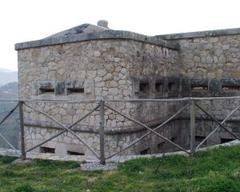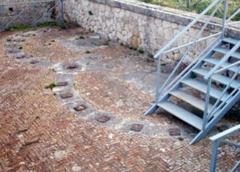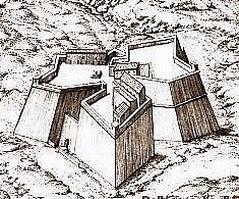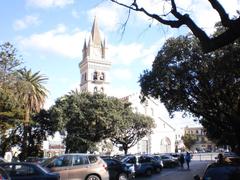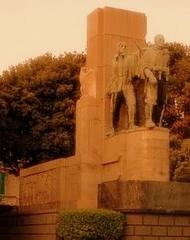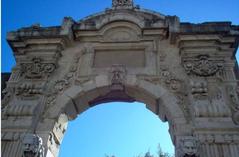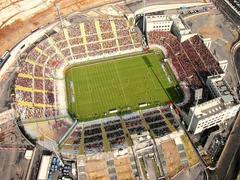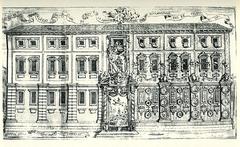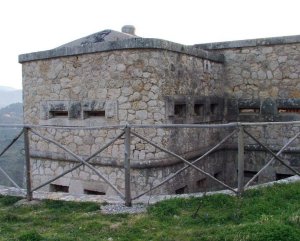
Forte dei Centri Visiting Hours, Tickets, and Historical Sites in Messina, Italy
Date: 14/06/2025
Introduction to Forte dei Centri and Its Historical Significance
Perched atop Montepiselli hill in Messina, Sicily, the Fort of the Centres—often identified as Forte dei Centri or more specifically as Forte Gonzaga—stands as a testament to centuries of military ingenuity and strategic importance. Together with the nearby Forte del Santissimo Salvatore on the San Raineri peninsula, these fortresses have played pivotal roles in defending Messina, controlling access to the Strait of Messina, and shaping the city’s history from ancient times through the Renaissance and into the modern era. Today, these sites invite visitors to explore star-shaped bastions, panoramic viewpoints, and the evocative remnants of a storied past. This guide provides detailed information on history, visiting hours, ticketing, access, and practical tips for experiencing these unique Messina historical sites (Wikipedia’s Forte Gonzaga, Spotting History’s Forte Gonzaga, official Messina tourism portal).
Contents Overview
- Introduction
- Historical Background and Significance
- Origins and Early History
- Renaissance Fortification and Architectural Evolution
- Role in Regional Conflicts
- Modernization and Restoration
- Architectural Features and Visitor Experience
- Forte del Santissimo Salvatore
- Forte Gonzaga (Forte dei Centri)
- Visiting Information
- Hours, Tickets, Accessibility, and Tours
- Amenities and Safety
- Getting There and Nearby Attractions
- Practical Visitor Tips
- Frequently Asked Questions (FAQ)
- Conclusion
- Sources
Historical Background and Significance
Origins and Early History
Messina’s fortifications occupy sites of strategic value since antiquity. The San Raineri peninsula, now home to the Forte del Santissimo Salvatore, has revealed evidence of Greek settlement dating to the 8th century BCE, and its natural harbor attracted successive empires, including Greeks, Romans, Byzantines, Arabs, and Normans (Wikipedia, ItalyGuides). In the Middle Ages, a monastery and the church of the Holy Saviour stood here, incorporating a tower built in 1081 that played a defensive role in the War of the Sicilian Vespers in 1282. Remnants of this medieval structure are integrated into the present fortress.
Renaissance Fortification and Architectural Evolution
The 16th century ushered in major upgrades to Messina’s defenses in response to Ottoman threats. Under Antonio Ferramolino, a leading military engineer, the Forte del Santissimo Salvatore was constructed in 1546, blending surviving medieval elements with Renaissance military design (Wikipedia). Its polygonal plan, bastions, and curtain walls represent state-of-the-art fortification, capable of withstanding artillery and facilitating effective defense. Similar advances are seen in Forte Gonzaga, whose star-shaped layout and angular bastions reflect evolving military strategies of the era (Wikipedia - Forte Gonzaga).
Role in Regional Conflicts
These forts have played central roles in Messina’s turbulent history. The Forte del Santissimo Salvatore and later Forte Gonzaga saw action during the uprising against Spanish rule (1674–78), the Sicilian revolution of 1848, and even the Expedition of the Thousand in 1861, marking steps toward Italian unification (Wikipedia, Wikipedia - Forte Gonzaga). In the late 19th century, the construction of additional forts such as Forte Cavalli responded to advances in artillery technology and shifting strategic needs (Enjoy Sicilia).
Modernization, Earthquakes, and Restoration
Messina’s fortifications have withstood not only war but natural disasters. The 1783 earthquake damaged the Forte del Santissimo Salvatore, and the catastrophic 1908 earthquake led to further destruction and loss of fortification walls (Wikipedia). Restoration efforts have preserved key features, and new symbols emerged—most notably, the Madonnina statue erected atop the medieval tower’s foundation in 1934, now a maritime icon of Messina (Shore Excursions Group).
Architectural Features and Visitor Experience
Forte del Santissimo Salvatore
- Layout: Renaissance polygonal plan with bastions, curtain walls, and surviving medieval tower.
- Features: Semi-circular bastion, artillery batteries, panoramic terraces, and the Madonnina statue.
- Visitor Experience: Self-guided exploration, interpretive panels, and panoramic views of the Strait of Messina (The Tourist Checklist).
- Access: Partial accessibility; uneven surfaces and stairs may limit mobility.
Forte Gonzaga (Forte dei Centri)
- Design: Star-shaped bastioned fortress with moat, curtain walls, and elevated position on Montepiselli hill.
- Interior: Chapel on the terrace, barracks, storage, and command posts.
- Restoration: Well-preserved; plans for museum and conference center underway.
- Significance: Named for Viceroy Don Ferrante Gonzaga, built under Antonio Ferramolino’s direction (Wikipedia - Forte Gonzaga).
- Views: Panoramic vistas over Messina, the Strait, and surrounding hills.
Visiting Information
Hours and Admission
- Forte del Santissimo Salvatore: Open Tuesday to Sunday, 9:00 AM–6:00 PM; closed Mondays and select holidays. General admission ~€5, with discounts for children, seniors, and groups (Wikipedia).
- Forte Gonzaga: Open daily, 9:00 AM–7:00 PM, but hours may vary seasonally or during restoration (Wanderlog). Entry is generally free; donations appreciated. Some events/tours require tickets.
Accessibility
- Mobility: Both forts have uneven terrain and stairs; partial accessibility. Contact sites in advance for assistance.
- Facilities: Basic restrooms; no cafés or shops on-site—bring water and snacks.
Guided Tours and Special Events
- Guided tours available in Italian and occasionally English; pre-book through local tourism offices or Messina tourism portal.
- Special events, open-air concerts, and exhibitions are common in summer; check schedules ahead.
Safety and Visitor Etiquette
- Wear sturdy shoes; stone surfaces can be slippery.
- Respect signage, avoid restricted areas, and do not climb on historic structures.
- Photography is encouraged; drone use may be restricted (Ellie’s Travel Tips).
Getting There and Nearby Attractions
Access
- By Car: Short drive or taxi from Messina’s port/city center. Parking is limited during peak times.
- Public Transport: Limited bus service; check ATM Messina for schedules.
- On Foot/Bike: Steep trails lead to both forts; bring water and sun protection.
Nearby Attractions
- Messina Cathedral: Iconic Norman-Byzantine cathedral in the city center.
- Real Cittadella: Another historic bastion close to the port.
- Regional Museum and Sanctuary of Montalto: Art, history, and panoramic city views.
- Camposanto Monumentale: Monumental cemetery with striking architecture (PlanetWare).
Practical Tips for Visitors
- Best Times: Visit in spring or autumn for mild weather and clear views.
- What to Bring: Comfortable shoes, hat, sunscreen, water, and a camera.
- Language: Italian is primary; some signage and tours in English. Consider a translation app.
- Booking: Check event and tour schedules in advance, especially for Forte dei Centri.
- Sustainability: Practice “Leave No Trace”; support preservation efforts.
Frequently Asked Questions (FAQ)
Q: What are the visiting hours for Messina’s forts?
A: Forte del Santissimo Salvatore is open Tuesday–Sunday, 9:00 AM–6:00 PM. Forte Gonzaga is open daily, 9:00 AM–7:00 PM, but check for updates.
Q: Is there an entry fee?
A: Forte del Santissimo Salvatore charges ~€5; Forte Gonzaga is generally free, with fees for special events or tours.
Q: Are guided tours in English available?
A: Tours are primarily in Italian; some English options may be arranged in advance.
Q: Are the forts accessible by public transport?
A: Limited bus service is available; taxis or private vehicles are more reliable.
Q: Can I use a drone for aerial photography?
A: Drone use is restricted; check local regulations.
Conclusion
Forte Gonzaga and Forte del Santissimo Salvatore are unmissable highlights of Messina’s historical landscape. Their strategic locations, architectural evolution, and resilience through centuries of upheaval offer a unique window into Sicily’s military and cultural heritage. With this guide, you can plan an enriching visit—take in panoramic views, explore centuries-old bastions, and immerse yourself in the living history of Messina.
For the latest updates, event schedules, and digital guides, download the Audiala app and follow local tourism channels. Make the most of your journey through Messina’s storied fortresses!
Sources and Further Reading
- Forte del Santissimo Salvatore – Wikipedia
- Forte Gonzaga – Wikipedia
- Forte Gonzaga – Spotting History
- Enjoy Sicilia: Forte Cavalli Messina
- Shore Excursions Group: Messina’s Must-Sees
- Messina Tourism Office
- ATM Messina Public Transport
- Fuse Travels: What to Do in Messina
- PlanetWare: Messina Attractions
Image Suggestions: Include high-quality photos of the forts’ exteriors, panoramic views over Messina, the Madonnina statue, and guided tours in progress. Use descriptive alt text such as “Panoramic view from Forte Gonzaga overlooking Messina”.
Consider embedding an interactive map highlighting the forts’ locations relative to Messina’s city center and key attractions.
